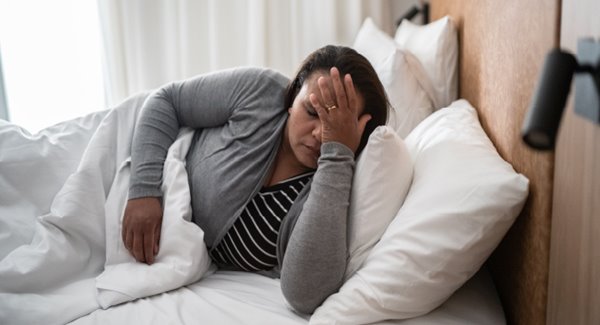Sleepless in the Service
Active military and veterans are dogged by insomnia, especially when they have arthritis pain. Learn how therapy can help.
By Jill Tyrer | June 14, 2022
When you’re in the military, you learn from day one of basic training that sleep is just as tightly scheduled as everything else: Lights out at 2100 (9 p.m.) and you’re up and at ‘em at 0500. Every activity is scheduled and if you’re late, there are consequences. Trouble sleeping? “Shake it off and pull it together” is the mentality. Tough people don’t need much sleep.
It’s hardly a surprise, then, that so many active and former military personnel have sleep disorders, explains Natalie Rolle, who works with veterans and active-duty service people as well as civilians as the lead occupational therapist (OT) in the Sleep Services Program at Colorado State University. Rolle is an expert in cognitive behavioral therapy for insomnia (CBT-I).
CBT-I is a model of therapy rooted in psychology designed to change one’s thoughts, beliefs, understanding and behaviors around sleep in order to alleviate insomnia.
“As of 2016, the American College of Physicians recommends CBT-I as a first-line treatment for chronic insomnia. It’s no longer medication,” Rolle says. In studies, CBT-I is effective for about 60% to 65% of those who try it. (Because it uses sleep restriction techniques, it’s not appropriate for those with seizure disorders or, without expert guidance, for bipolar disorders.)
On Alert
Post-traumatic stress disorder or untreated concussions play a role in sleep problems for some active military and veterans, Rolle says. More often, they report hyperarousal.
“In veterans, hyperarousal can mimic what sleep apnea or restless legs [syndrome] would look like, where they’re waking 10 to 15 times a night, but for a short amount of time — two or three or four minutes for each wakening,” she says.
As a result, people feel constantly hazy and fatigued, which affects their ability to function, their quality of life and — for those with chronic pain — their level of pain. But while it takes on average of five years for most people to seek help, it takes even longer for service personnel — if they do so at all. “When you have this ‘I don’t want to be the weak link in the chain’ mentality, it’s very difficult even after service to come out and say, ‘Well, I’m not sleeping very well and I need help,’” Rolle says.
Some simply don’t recognize what’s happening. They believe they still stick to strict schedules, including sleep, until they keep a sleep diary that shows that’s not the case. Others figure they don’t really have a problem because it takes them only an hour and a half to get to sleep when it used to take three or more hours.
But if it takes 30 minutes or more to fall asleep or you wake up throughout the night for 30 minutes or more, or if you wake up at least 30 minutes before your alarm at least three days a week for at least 3 months, that’s diagnosable chronic insomnia, Rolle says. If it’s been happening for three weeks to three months, it is defined as acute insomnia.
Pain and Sleep
Sleep may be even more elusive for active military and veterans who live with arthritis pain. Not only can pain disrupt restful sleep, but poor sleep can worsen pain perception.
CBT-I may not be as effective for some people with chronic pain as those without it, but it still can help, Rolle says. Before treating someone with chronic pain, she makes sure their pain is as well managed as possible. She puts her occupational therapy skills to work for them, focusing on activities, mattress, pillow, positioning and techniques to relieve pain.
“With some patients, you will get better with CBT-I, but chronic pain can be a limiting factor,” she says. “Once we do positioning, once we get quality of sleep maintained, once we know they’re working with a pain specialist, working through that pain and managing it, there’s only so much you can do, but there’s still improvement. I think that’s the biggest thing to highlight: For example, 17% improvement in sleep efficiency, even if it’s only 15 minutes more total sleep time overall, means it’s better-quality sleep — you’re sleeping deeper and more typically.”
Some patients report that CBT-I reduces their pain, so they can do more. Others report that improved sleep makes them more aware of their pain, but that awareness makes them better able to manage it.
“They’ll say, ‘I notice an increase in pain but I’m actually still able to do more. It’s just that that the fog has lifted from my chronic insomnia, and when that fog lifted, I became more aware of the sensations in my body and what was going on,’” Rolle explains.
Simply being able to sleep more restfully to recharge your body and mind may ease pain.
“If you have arthritis pain and you haven’t thought about sleep as one of the avenues to improve your pain, it’s definitely something you need to start thinking about as part of your toolbox,” Rolle says.
“We know sleep and pain/inflammation are very related to each other. They’re bidirectional,” so better quality sleep contributes to lower inflammation and pain, she explains. “And we know there are literal connections between the pain itself, how intensely we feel it when we’re sleeping well and when we’re not. So don’t short yourself on the sleep side.”
How to Improve Your Sleep
“Sleep hygiene” measures — like keeping a dark, cool bedroom; limiting alcohol and caffeine; and restricting electronic screens — has a role in sleep therapy, but most research has shown that it takes more than sleep hygiene alone to provide a significant improvement in sleep, Rolle says.
Her recommendation: Stimulus control, which is key to CBT-I, is proven to help. These five steps can go a long way to helping you sleep better.
- Get up at the same time every single day. “That’s probably the strongest factor,” even more so than going to bed at the same time, Rolle says. “The circadian system is much more bothered by variations in wake time [than bedtime].”
- Limit napping. The best thing you can do if you are having trouble sleeping is not nap. If you are going to nap, keep it to 30 minutes and before 1-2 p.m. The later you nap, the more it affects your ability to get good sleep at night. If you have trouble getting up after a bad night — due to pain, for example — get up at the normal time and expose yourself to light to help reset your circadian rhythm. After 20-30 minutes, if you’ve decided thoughtfully that you need more sleep, take a 30-minute nap early in the day, so you can still get to sleep that night.
- Restrict bed activities to sleep and sex. If you do other activities in bed, like reading, playing video games or even thinking and planning, then you’re training your brain to understand that the bed is the right place for those activities.
- If you’re not sleeping in bed, get up. If you’ve been lying awake in bed long enough to start wondering how long you’ve been lying awake in bed — without watching the clock — then get up, go to another room (or a chair in the bedroom if necessary) and do something relaxing, like reading or working on a Sudoku puzzle or a coloring book. If pain, balance problems or other issues keep you from leaving the bed, then differentiate your sleeping space. “If the lights are off and you’re lying down, you’re trying to sleep. If you’re sitting up and lights are on, you’re not trying to sleep.”
- Stay active during the day. Physical activity doesn’t only ease arthritis pain. Staying active and engaged also boost mental and emotional health and improves sleep quality.
For the best quality sleep, take all of these measures at the same time and consistently. However, just starting with getting up at the same time each day can help, but results may take longer, Rolle says.
Sign Up for Updates
You have much to gain by staying on top of the latest information, tips and resources offered by the Arthritis Foundation and our community. Learn about upcoming webinars, new e-books and podcasts, medical breakthroughs and more. Be in the know and live your best Yes.


